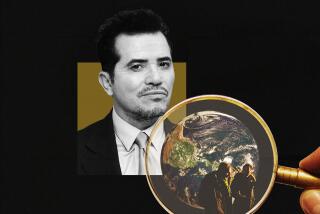Missing From Hollywood’s Big Picture: Latino Heroes
- Share via
Television news images of yellow ribbons clinging from homes in East Los Angeles and Huntsville, Texas, as two Mexican American families anxiously await word about their captured sons in Serbia, raise anew an old question: Why has the ubiquitous and courageous participation of Latinos in America’s wars eluded public recognition?
I think I know the answer to this. Ten years of trying to get a true story of Mexican American heroism in World War II made into a motion picture has taught me. At the core is the prevalent perception of race embraced by the Hollywood producing community--a view that race is exclusively defined as a black and white dichotomy. This establishes a “food chain” of racial importance that values stories about some minorities (African Americans, for example) as worthy of production while deeming stories about other ethnic groups (Mexican Americans, for example) as unworthy of being told--too far down on the food chain.
The grief of the Ramirez and Gonzales families today recalls the grief shared by 22 Mexican American families on a tiny street in the Midwest more than 50 years ago. For the 22 families of 2nd Street in Silvis, Ill., the Second World War was an opportunity for their sons, brothers and fathers to prove their loyalty and patriotism for their country. At the time, the large, extended Mexican American families of 2nd Street did not know that more men and women from their tiny block would volunteer for the war effort than from any other street of its size in the United States--a total of 65 people from 22 families on a street only a few hundred yards in length. They paid dearly: Six young men died during World War II and two more during the Korean conflict.
Ironically, while the eight heroes of 2nd Street were defending their country, winning the war overseas, their families were losing the war at home. During the decades of the 1940s, 1950s and 1960s, efforts to get dusty 2nd Street paved were denied by the Silvis City Council. It was not until 1975 that 2nd Street was finally paved and given the name it bears today: Hero Street USA.
For the last 10 years, Joseph Castel, a descendant of one of the 2nd Street families, and I have tried to get the story of Hero Street USA told as a motion picture. We have been met by a resounding “no” from virtually every major production entity in Hollywood. The reasons given range from the perception that the story is too costly a “period piece” to the allegation that there are insufficient Latino marquee stars around to carry the story. I suspect that the real reason has more to do with an unconscious but entrenched mentality on race relations in the minds of Hollywood producers.
While Hollywood producers have (at last) recognized the sacrifice of African Americans in defense of their country during the Civil War (“Glory”), the Second World War (“A Soldier’s Story,” “Tuskegee Airmen”) and Vietnam (“The Walking Dead”), the narrative story of Latinos defending their country has been told only once, in the 1945 film “A Medal for Benny.” This, in spite of the fact that Mexican Americans and other Latinos have fought in all of America’s wars (yes, even the Civil War). During World War II, Spanish-surnamed Americans were awarded more Medals of Honor than any other ethnic group. Raul Morin has chronicled dozens of stories of Latino heroism in his book “Among the Valiant.”
Those of us familiar with the large number of Latinos in the armed forces today find such popular American films as “Independence Day,” “Armageddon” and “Deep Impact” offensive in their exclusion of this presence. In each of these films the American military is depicted without one single Latino character. Indeed, the only Latinos depicted in “Independence Day” and “Deep Impact” are stereotypical Mexican farm workers (one of the three prevalent stereotypes of Latinos in television and motion pictures, the other two being the gang-banger and the so-called “illegal alien”).
At heart in this selective retelling of history is a pervasive perception of race. In Hollywood, race is still a matter of black and white. There are historical reasons for this. For many years, the legacy of the Civil War and the impact of the 1960s civil rights movement virtually equated race with African Americans in the minds of most Americans. There are other reasons as well. African Americans have for many years been the largest ethnic minority in the United States and geographically are to be found throughout the United States (unlike Mexican Americans, who, until recently, have been found predominantly in the Southwest). While this may explain why Hollywood producers are more aware of African Americans, it does not justify why Mexican Americans, Asian Americans and Native Americans continue to be excluded from the larger palette of American cinema and television.
Indeed, the myth of an America defined by a black and white dichotomy is being challenged daily by the reality of the multicultural and polyglot America reflected in demographic studies. In Los Angeles, where the majority of America’s motion pictures and television programs are produced, the population is 44% Latino. (That’s almost every other person in Southern California!) Nationally, Latinos make up 11% of the U.S. population, and the United States Census projects that, in the next five years, Spanish-surnamed Americans will comprise the largest ethnic minority in America. In spite of these statistics, and ignoring the $6 billion a year spent by Latinos on entertainment, Hollywood producers still think black and white.
It is time for Hollywood producers, and all Americans, to recognize that our country is made up of many different ethnic groups, people whose sacrifices and contributions deserve to be depicted on the large and small screen. If there is any doubt about this, look to the yellow ribbons hanging from homes in East Los Angeles and Huntsville, Texas.


